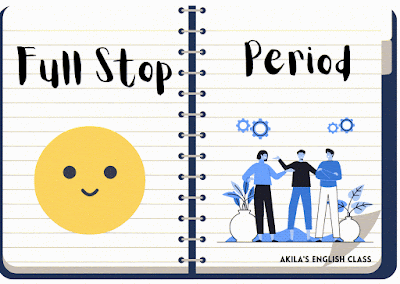The 3 terminal punctuation marks
Punctuation is very important to bring coherence
and structure to written material. This post details the use of terminal
punctuation marks namely the full stop,
the question mark and the exclamation mark. They are very important as they
convey to the reader that an idea/thought has been wrapped up and come to an
end. Every sentence with a few exceptions ends with one of the three terminal
punctuation marks.
Terminal Punctuation Marks (used at the end of sentences)
1. Full Stop (.)
Terminal Punctuation Mark- A full
stop, a question mark or an exclamation mark - is always written next to the
last letter of the last word of the sentence without any white space between.
The Full Stop
Full
Stop / period is one of the most
commonly used punctuation marks. There are many places which require the use of
Full Stop.
While in British English it is
called as Full Stop or Full Point, in American English it is named as a Period.
The
Full Stop/Period is used
1.
At the end of sentences
Full Stop/Period is used to indicate strong pause when used at the end of sentences that are not questions or exclamations.
Example: I am Anand.
2. After abbreviations
An
abbreviation is a shortened way of writing a word.
Abbreviations
are different from contractions. The difference between the two is the way they
are pronounced. Whereas an abbreviation does not have a distinct pronunciation,
contractions have distinct pronunciation.
Examples:
subj., etc., Pres., adj., Dec., Fri., Univ.
Note: Dr Vijay which could also be
written as Doctor Vijay.
After a.m. (`before noon') and p.m. (`after noon')
Example: 11.00 a.m.
Note: These are not capitalized in British usage but American usage prefers 11.00 am, with small capitals and without full stops.
* In
typography, small caps (short for small
capitals) are lowercase characters typeset with glyphs that resemble uppercase
letters (capitals) but reduced in height and weight, close to the
surrounding lowercase letters or text figures.
3. After initials
A person’s initials are also abbreviations. Hence a full stop follows initials of persons. Increasingly, however, there is a tendency to write such initials without full stops.
Example: A.A. Milne (Alan Alexander Milne), G.B.
Shaw (George Bernard Shaw), P.B. Shelley (Percy Bysshe Shelley), P.G.
Wodehouse (Pelham Grenville Wodehouse)…
Note: A rare case was
Harry S Truman: the S in this name never takes a full stop
because it's not an abbreviation for anything; President Truman's parents
actually gave him the middle name S.
ATTENTION! When an
abbreviation comes at the end of a sentence, only one full stop is
used. Never use two full stops in a row.
There are a number of Latin
abbreviations which are used commonly in English writing. Here are the
commonest ones with their English equivalents:
e.g. Latin phrase exempli
gratia meaning for example
i.e. is an abbreviation for
the phrase id est, which means "that is." I.e. is used to
restate something said previously in order to clarify its meaning. in other
words
viz. The
abbreviation viz. (or viz without a full stop) is short for the
Latin videlicet, which itself is a contraction of the Latin phrase videre
licet, meaning "it is permitted to see". It is used as a
synonym for "namely", "that is to say", "to wit", "which is", or "as follows"
etc. etcetera; and so on;
and other things of a similar kind and so forth
When using these Latin abbreviations, it is important to
punctuate them correctly.
Every sentence must have a subject, a verb and should express complete thought. Sentence fragment misses one or more of the above three things. A Fragment must be avoided in formal writing. On the other hand a fragment gives the drama and emphasis needed in creative writing.
Fragment
should always end with a full stop, a question mark or an exclamation mark, as
appropriate.
Example:
Can I have
another scoop of ice cream? Of course!
I need to go home. But how?
Where there is no FULL STOP
1. Full Stop is NOT used with initials.
Initialism is
where initial letters of words form an abbreviation and the letters are
pronounced separately.
UK (United Kingdom), BBC (British Broadcasting Corporation), CNN (Cable News network) – these words are examples of initialism.
Full Stop does not separate these letters.
2. Full Stop is NOT used with Acronyms.
An Acronym is the new word formed from the initials if a group of words. Acronym is pronounced as spelt. Full Stop does not separate the letters in Acronym. Some examples – NATO (North Atlantic Treaty Organisation), UNICEF (The United Nations International Children's Emergency Fund), DOB (Date of Birth), DIY (Do It Yourself), ESL(English As Second Language), FAQ (Frequently Asked Questions).







1 Comments
The 3 Terminal Punctuation Marks - The Full Stop >>>>> Download Now
ReplyDelete>>>>> Download Full
The 3 Terminal Punctuation Marks - The Full Stop >>>>> Download LINK
>>>>> Download Now
The 3 Terminal Punctuation Marks - The Full Stop >>>>> Download Full
>>>>> Download LINK NL